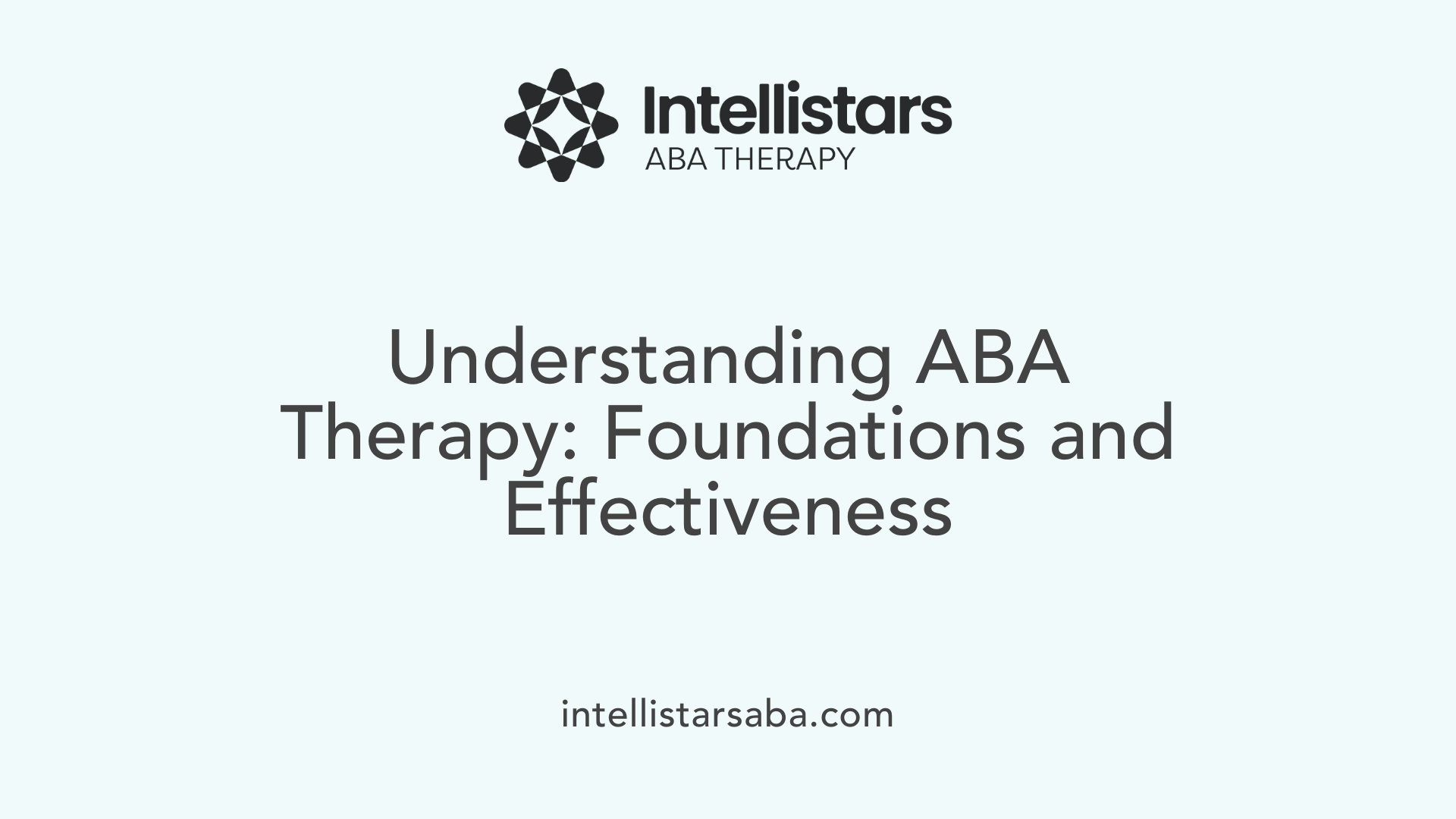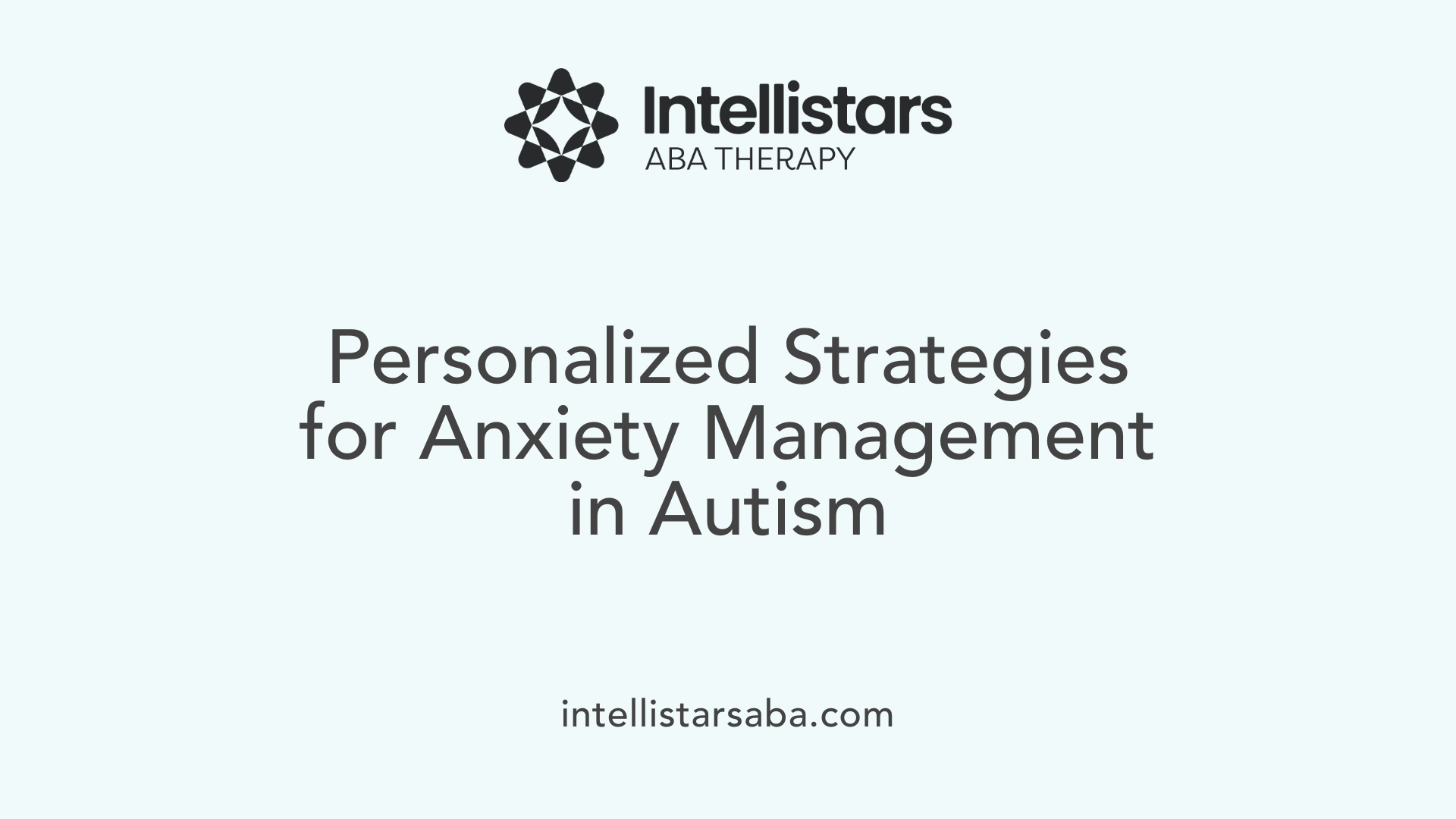Understanding Anxiety in Autism and the Role of Behavioral Approaches
Anxiety is a prevalent and often challenging condition for individuals with autism spectrum disorder (ASD), intensifying core autism traits and impacting quality of life. Behavioral strategies, grounded in learning theories and specifically adapted to the unique needs of autistic individuals, offer promising interventions to manage anxiety and stress. This article explores the underpinnings of these approaches, highlighting applied behavior analysis (ABA), cognitive-behavioral therapies, exposure techniques, and carer involvement as key components in supporting autistic individuals.
Applied Behavior Analysis (ABA) Therapy: Foundations and Function

What is Applied Behavior Analysis (ABA) therapy and how does it work for autism?
Applied Behavior Analysis (ABA) therapy is a scientifically validated approach designed to support individuals with autism by applying principles of learning and behavior analysis. It focuses on increasing essential skills and reducing challenging behaviors through systematic interventions.
ABA therapy works by examining the relationship between antecedents (what happens before a behavior), behaviors themselves, and consequences (what happens after a behavior), often called the 'A-B-Cs' of behavior. This method helps in identifying and reinforcing positive behaviors while decreasing unwanted ones.
How ABA uses learning principles
ABA relies heavily on contemporary learning theories such as classical and operant conditioning. Positive reinforcement plays a central role, where desirable behaviors are encouraged by rewarding them, thereby increasing the likelihood they will occur again. For example, if a child responds appropriately to a social cue, receiving praise or a favorite item encourages repetition of that behavior.
Techniques and methods in ABA
Various structured techniques fall under the umbrella of ABA therapy, including Discrete Trial Training (DTT) and Pivotal Response Treatment (PRT). DTT breaks tasks into small, manageable steps through repeated trials, while PRT focuses on improving pivotal areas like motivation and response to multiple cues.
ABA programs frequently incorporate visual aids, clear communication methods, and gradual exposure to new tasks or situations, tailored to individual capabilities. The therapy also includes teaching coping skills and uses reinforcement to generalize behaviors across settings.
Personalization and effectiveness of ABA
ABA programs are highly personalized, beginning with thorough assessments by trained professionals who identify specific goals based on the individual's needs. This customization ensures the therapy addresses the unique cognitive, social, and sensory profiles of each autistic individual.
Research consistently affirms ABA's effectiveness, particularly when implemented intensively and at an early age. It can lead to significant improvements in IQ, language development, social skills, and daily functional abilities. Furthermore, ABA promotes greater independence and enhances overall quality of life for individuals with autism.
Below is a summary table capturing these details:
| Aspect | Description | Example/Notes |
|---|---|---|
| Definition | Science-based approach to teaching skills and modifying behavior | Uses learning and behavior principles |
| Learning Principles Used | Classical and operant conditioning, reinforcement | Positive reinforcement central |
| Techniques Employed | Discrete Trial Training, Pivotal Response Treatment, visual supports | Structured, step-wise programs |
| Personalization | Tailored goals and methods based on individual assessment | Adapts to sensory and communication needs |
| Effectiveness | Proven improvements in language, social skills, and adaptive functioning | Best outcomes with early, intensive intervention |
This comprehensive approach ensures that ABA therapy meets diverse needs within the autism community effectively and compassionately.
Understanding Anxiety in Autism: Prevalence and Complexities

What Are the Prevalence Rates of Anxiety in Autism?
Anxiety is frequently observed in individuals with autism spectrum disorder (ASD), with studies up to 2019 reporting prevalence rates around 40% in autistic children and adolescents and 50% in autistic adults. This is notably higher than anxiety rates in non-autistic populations, highlighting the significant co-occurrence of anxiety and autism.
How Do Autism and Anxiety Symptoms Overlap?
Autism and anxiety share some genetic and symptomatic characteristics, which can complicate diagnosis and treatment. For example, increased repetitive behaviors, avoidance, sleep disruptions, or somatic complaints like stomachaches may be expressions of anxiety but also core features of autism. Sensory sensitivities and difficulties with unpredictable environments further intertwine autistic traits with anxious responses.
What Types of Anxiety Disorders Affect Autistic Individuals?
The Diagnostic and Statistical Manual of Mental Disorders (DSM-5) identifies several anxiety disorders commonly experienced by people with autism, including:
- Separation anxiety
- Social anxiety
- Generalized anxiety
- Specific phobias
- Unspecified anxiety disorder
Additionally, research highlights a category known as ambiguous anxiety that involves social fears, idiosyncratic phobias, fear of change, and fears related to special interests — possibly even more prevalent than traditional DSM categories.
What Challenges Exist in Diagnosing and Assessing Anxiety in Autism?
Assessment is complicated by symptom overlap and the varied ways anxiety manifests in autistic individuals. A careful process involving behavioral observations, collaboration with autism specialists, and consideration of each individual's communication abilities is needed. These challenges necessitate multidimensional approaches to evaluation to differentiate anxiety from autism symptoms and tailor appropriate interventions.
Theoretical Foundations: Learning Theories Informing Anxiety Interventions

Role of classical conditioning in anxiety
Classical conditioning helps explain how anxiety develops through learned associations between neutral and feared stimuli. In autistic adults with learning disabilities, neutral environmental cues can become linked with anxiety-provoking experiences. Over time, these cues alone may trigger anxiety responses, even in safe situations.
Operant conditioning principles
Operant conditioning focuses on how behaviors are influenced by consequences. In anxiety interventions, reinforcement is used to encourage coping and relaxation behaviors. When individuals successfully manage anxiety or face feared situations, positive reinforcement strengthens these adaptive responses, helping reduce avoidance.
Vicarious conditioning relevance
Vicarious conditioning, or learning through observation, is important in anxiety management. Autistic adults often learn strategies by observing carers or therapists modeling relaxation and coping techniques. This observational learning can promote skill acquisition without direct exposure to stressful situations initially.
How learning theories explain anxiety in autism
Together, classical, operant, and vicarious conditioning provide a comprehensive framework to understand and treat anxiety in autism. These theories inform targeted interventions such as graded exposure, reinforcement, and carer involvement. By addressing the learned aspects of anxiety, this approach supports gradual desensitization and skill generalization tailored to individual sensory and communication needs.
Core Components of Behavioral Interventions for Anxiety in Autism

What Are the Benefits of Psychoeducation?
Psychoeducation forms the foundation of behavioral interventions for anxiety in autistic individuals. It helps people recognize both physiological and cognitive signs of anxiety. By understanding their own anxiety responses, they gain tools for better self-regulation and increased awareness. This educational component also supports caregivers by clarifying anxiety triggers and coping techniques.
What Relaxation Training Methods Are Used?
Relaxation is crucial for managing anxiety symptoms such as muscle tension and rapid heartbeat. Techniques include deep diaphragmatic breathing, progressive muscle relaxation, and sensory integration approaches like calming sounds or soothing scents. These are adapted to individual sensory needs, helping individuals counteract the fight-or-flight response in overwhelming situations.
How Does Graded Exposure Work with Fear Ladders?
Graded exposure leverages a fear ladder, a step-by-step hierarchy from less to more anxiety-provoking stimuli. Through gradual and repeated exposure paired with relaxation, individuals systematically desensitize to feared situations. This approach builds tolerance and reduces avoidance behaviors by reinforcing successful coping at each stage.
What Reinforcement Strategies Support Anxiety Reduction?
Positive reinforcement plays a vital role in encouraging approach behaviors and skill building. Rewarding progress with preferred interests or tangible feedback motivates continued engagement. Reinforcements help embed new skills and minimize avoidance by associating anxiety-provoking tasks with positive outcomes.
Why Is Carer Involvement Important?
Carers are integral, assisting in delivering interventions and tailoring strategies to individual needs. They offer ongoing support that generalizes skills beyond therapy sessions. Caregiver training sessions enhance their ability to manage anxiety approaches, promote consistency, and reduce over-accommodation that may unintentionally maintain anxiety.
Adapting Behavioral Interventions to Individual Needs

Use of Visual Aids and Social Stories
Behavioral interventions for autistic adults with moderate to severe learning disabilities extensively utilize visual supports such as visual schedules and social stories. These tools help present information clearly and predictably, reducing anxiety linked with uncertainty. Visual schedules outline the session structure, while social stories illustrate social situations or coping strategies, making abstract concepts more accessible.
Communication Adaptations
Given the communication differences common among autistic individuals, tailored adaptations are essential. Interventions incorporate aided communication systems alongside visual schedules to support expression and comprehension. These communication methods accommodate varying verbal abilities and help in conveying instructions, emotions, and feedback effectively.
Sensory Considerations and Integration
Anxiety in autism often interacts with sensory sensitivities. Relaxation techniques are adapted to individual sensory profiles, incorporating calming sounds, fidget tools, or soothing scents. Sensory integration strategies complement behavioral techniques by managing over-stimulation, which is a common trigger for anxiety.
Carer Training and Engagement
Carers play a pivotal role in intervention success. The program includes dedicated sessions for caregiver training, ensuring carers understand individual needs and the intervention methods. Carers assist in generalizing skills beyond therapy settings, provide reinforcement, and support relaxation and graded exposure exercises at home. This collaborative approach integrates carer insights and facilitates consistent anxiety management across environments.
Cognitive-Behavioral Therapy (CBT) and Modified Approaches for Autism
How effective is CBT for autistic children and youth?
CBT is recognized as a highly effective treatment for severe anxiety in children with autism, especially those with some verbal ability. Studies indicate that it is more effective than other talk therapies for this group. When adapted as Modified CBT (MCBT), it caters to autistic youths without significant language or cognitive delays, making it a favored approach.
What are the core elements of modified CBT?
Modified CBT integrates several key components tailored to autistic children and adolescents:
- Psychoeducation: Teaching individuals to recognize physical and cognitive signs of anxiety, aiding in self-awareness and regulation.
- Relaxation Training: Techniques such as diaphragmatic breathing and muscle relaxation help counter the fight-or-flight response.
- Behavioral Coping Strategies: Including graded or hierarchical exposure to feared stimuli and engagement with interests.
- Carer Involvement: Training caregivers to support and reinforce strategies at home.
How is exposure therapy implemented within CBT?
Exposure therapy is delivered through a fear or graded exposure hierarchy, where individuals gradually confront anxiety-provoking situations step-by-step. This approach helps desensitize fearful responses systematically while pairing exposure with relaxation techniques to manage physiological symptoms.
What role does cognitive restructuring play in managing anxiety?
Cognitive restructuring is crucial in challenging maladaptive thoughts such as catastrophizing or worst-case scenario thinking. Therapists guide individuals to question these thoughts, explore alternative explanations, and reduce distorted fears, reinforcing more adaptive cognitive patterns.
This multifaceted approach makes CBT, particularly its modified forms, a cornerstone for anxiety treatment in autistic youth, promoting skill development and lasting anxiety reduction.
Supporting Anxiety Management through Environmental and Sensory Strategies
How can predictability be established with visual schedules?
Visual schedules play a crucial role in managing anxiety for individuals with autism by creating a predictable environment. These schedules use pictures or symbols to outline daily activities, helping reduce uncertainty and stress by clearly indicating what will happen next. This visual structure supports comprehension and decreases anxiety caused by unexpected changes.
Why is providing advanced notice of changes important?
Giving individuals advanced notice before changes occur allows them to prepare emotionally and mentally. This practice helps diminish anxiety triggered by surprises or sudden transitions. Informing changes ahead of time, often using visual or verbal cues, allows autistic individuals to adjust their expectations and cope better with alterations in routine.
In what ways can flexibility be practiced gradually?
Flexibility skills can be improved through controlled and supportive activities that gently introduce change. Using games or exercises that incrementally increase unpredictability encourages individuals to adapt without overwhelming them. Gradual exposure to flexibility helps build tolerance and confidence in handling new or unexpected events.
What sensory engagement techniques assist in relaxation?
Sensory strategies are effective in calming the nervous system and managing anxiety. Techniques include calming sounds such as soft music, interaction with fidget toys to provide tactile stimulation, and soothing scents to promote relaxation. Tailoring sensory input to individual preferences helps reduce sensory overload and supports emotional regulation in stressful moments.
Together, these environmental and sensory approaches create a supportive framework for autistic individuals to manage anxiety by enhancing predictability, preparing for changes, fostering adaptability, and employing calming sensory experiences.
The Critical Role of Caregivers: Collaboration and Home-Based Support
How Are Caregivers Involved in Delivering Anxiety Interventions?
Caregivers are essential partners in the anxiety intervention for autistic adults with moderate to severe learning disabilities. They assist therapists by providing insight into the individual's unique needs, help implement strategies like graded exposure and relaxation exercises, and support the consistent use of visual aids and positive reinforcement techniques outside of sessions. This hands-on involvement ensures that therapeutic practices extend beyond clinical settings into everyday life, enhancing their impact.
What Training Do Caregivers Receive During the Intervention?
Caregivers participate in dedicated training sessions as part of the 12-session intervention, gaining skills tailored to managing anxiety in autism. Training includes understanding anxiety triggers, applying relaxation strategies such as deep breathing and muscle relaxation, and learning to use visual schedules and social stories effectively. Continuous supervision and resources like intervention manuals strengthen caregivers' confidence and competence.
How Does Reducing Family Accommodation of Avoidance Behaviors Help?
Reducing over-accommodation by families—such as enabling avoidance of feared stimuli—plays a crucial role in anxiety reduction. Caregivers are guided to support individuals in facing fears incrementally, promoting skill-building and resilience. This approach encourages autonomy and prevents reinforcing anxiety through avoidance, fostering greater emotional regulation and independence.
How Do Caregivers Support Skill Generalization and Promote Self-Care?
Caregivers help generalize learned coping skills to various environments by providing consistent practice opportunities and positive reinforcement during daily routines. They also encourage self-care practices by facilitating the use of relaxation techniques and sensory strategies tailored to individual needs. This ongoing support nurtures long-term anxiety management and improves quality of life.
Professional Training and Resources for Effective Anxiety Interventions
Specialized therapist training and supervision
Therapists delivering anxiety interventions for autistic adults with moderate to severe learning disabilities undergo specialized training to ensure high-quality care. This includes a 2-day online course focusing on contemporary learning theories and practical techniques like graded exposure and relaxation. Ongoing supervision and professional support reinforce skill development and help maintain adherence to intervention protocols.
Use of manuals, handbooks, and assessment tools
A structured toolkit supports therapy delivery and monitoring, comprising intervention manuals, handbooks, visual schedules, and assessment forms. These materials guide therapists and carers in applying psychoeducation, relaxation strategies, and exposure hierarchies effectively while adapting interventions to individual communication and sensory needs.
Inclusion of advisory groups in intervention development
Intervention development actively involves an Inclusive Advisory Group, consisting of autistic adults and stakeholders. This collaboration ensures that treatments are relevant, respectful, and practically appropriate for the target population, enhancing acceptability and outcomes.
Guidance from professional organizations
Professional bodies such as the Association of Behavioral and Cognitive Therapists provide valuable resources for therapists and families. They facilitate locating qualified therapists and offer evidence-based guidelines for implementing cognitive behavioural therapy and related techniques, strengthening therapy effectiveness in autism-related anxiety management.
Integrating Behavioral Strategies to Support Autistic Individuals with Anxiety
Managing anxiety and stress in individuals with autism requires a comprehensive, evidence-based approach grounded in behavioral principles and adapted to their unique needs. Applied Behavior Analysis, cognitive-behavioral therapy, and relaxation techniques, combined with graded exposure and sensory considerations, form an effective framework. Central to success is the involvement of caregivers, specialized training for therapists, and the use of tailored resources that accommodate communication and sensory differences. Through collaborative efforts and personalized interventions, individuals with autism can develop resilience, improve emotional regulation, and enhance overall well-being.
References
- Intervention description - NCBI - NIH
- Managing anxiety in children with autism
- Stress & Anxiety Reduction
- Managing Anxiety: Tools and Strategies for Emotional ...
- Applied Behavior Analysis (ABA)
- The effectiveness of applied behavior analysis program ...
- Applied Behavior Analysis (ABA)
- The effectiveness of applied behavior analytic interventions ...






